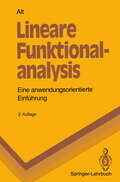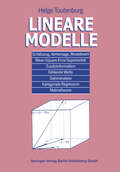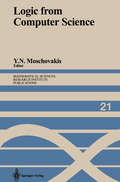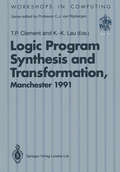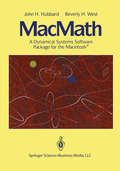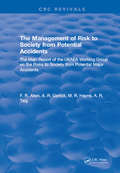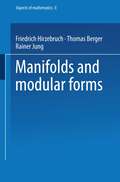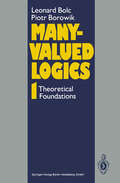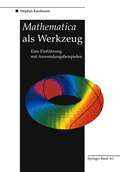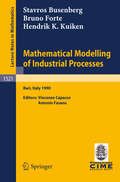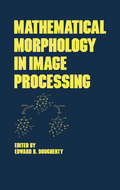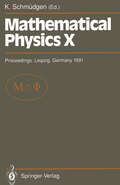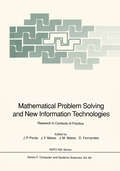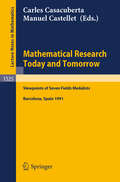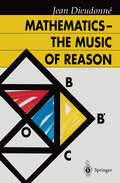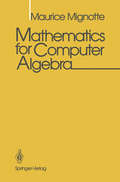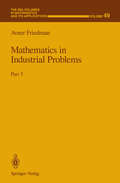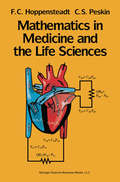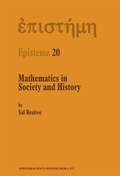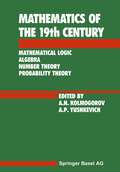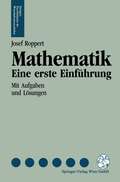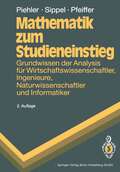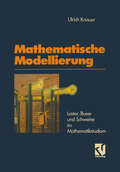- Table View
- List View
Lineare Funktionalanalysis: Eine anwendungsorientierte Einführung (Springer-Lehrbuch)
by Hans W. AltDer Anhang 5 dient zur Vertiefung des Studiums der Sobolev-Räume. Viele der während der Vorlesung gestellten Übungen sind mit Lösungen in das Buch aufgenommen worden, andere als Übungen hinzugenommene Aussagen sind als Ergänzung zum Grundstoff gedacht. Ich glaube daher, daß sich dieses Buch als Grundlage und ebenso als Begleitlektüre zu Vorlesungen über lineare Funktion alanalysis eignet, aber auch als Ergänzungsliteratur zu ~deren Vorlesungen. Besonders zu danken habe ich Eberhard Bänsch und Jürgen Dennert, die durch unzählige Hinweise und Verbesserungsvorschläge zur endgültigen Version des Buches beigetragen haben. Schließlich wäre das Buch nicht entstanden ohne die Arbeit von Angelika Schofer, die das Manuskript mit dem '!EX-System gesetzt hat und der das Buch seine äußere Gestaltung verdankt. Bonn, Juli 1985 H. W. Alt Inhaltsverzeichnis Einleitung . . . . . . . . . . . . . . . . . . . . . . . . . . . . . . . . . . . . . . . . . . . . . . . . . •. . . . . . . . . . . . . 1 0. Strukturen . . . . . . . . . . . . . . . . . . . . . . . . . . . . . . . . . . . . . . . . . . . . . . . . . . . . . . . . 8 0. 1 Topologie - 0. 2 Metrik - 0. 3 Abstand zweier Men gen - 0. 4 Topologie metrischer Räume - 0. 5 Offene und abgeschlossene Mengen - 0. 6 Vollständigkeit - 0. 7 Ver vollständigung - 0. 8 Frechet-Metrik - 0. 9 Norm - 0. 10 Folgenräume - 0. 11 Skalarprodukt Übungen 0 . . . . . . . . . . . . . . . . . . . . . . . . . . . . . . . . . . . . . . . . . . . . . . . . . . . . . . . 16 Ü 0. 5 Hausdorff-Abstand 1. Funktionenräume . . . . . . . . . . . . . . . . . . . . . . . . . . . . . . . . . . . . . . . . . . . . . . . 20 1. 1 Maße - 1. 2 Meßbare Funktionen - 1. 3 Raum meßbarer Funktionen - 1. 4 Raum beschränkter Funktionen - 1. 5 Stetige Funktionen - 1. 6 Räume stetiger Funktionen - 1. 7 Klassische Funktionenräume - 1. 9 Beispiele von Maßen - 1. 10 Lebesgue-Räume - 1. 12 Hölder-Ungleichung - 1.
Lineare Modelle
by Helge ToutenburgNeben dem Standard der Linearen Modelle behandelt das Lehrbuch eine Reihe neuer Methoden, Kriterien und Resultate. Auf der Basis neuerer Ergebnisse der Matrixtheorie werden Gütevergleiche zwischen verzerrten Schätzungen möglich, die den Einsatzbereich schwacher Zusatzinformation und von Imputationsverfahren bei unvollständiger Designmatrix erweitern. Die Einarbeitung dieser Resultate einerseits und die Berücksichtigung von Modellwahlverfahren (mit SPSS), von Imputationsmethoden für fehlende Daten, von Sensitivitätsbetrachtungen und der kategorialen Regression andererseits bedeuten eine wesentliche Erweiterung des Methodenangebots vergleichbarer Bücher zu Linearen Modellen. Ein eigenes, relativ umfangreiches Kapitel zur Matrixtheorie stellt die notwendigen methodischen Hilfsmittel für die Beweise der Sätze im Text bereit und vermittelt eine Auswahl klassischer und moderner algebraischer Resultate. Durch die Einarbeitung von Beispielen wird die Anwendung der Schätz- und Modellwahlverfahren demonstriert.
Logic from Computer Science: Proceedings of a Workshop held November 13–17, 1989 (Mathematical Sciences Research Institute Publications #21)
by Yiannis N. MoschovakisThe volume is the outgrowth of a workshop with the same title held at MSRI in the week of November 13-17, 1989, and for those who did not get it, Logic from Computer Science is the converse of Logic in Computer Science, the full name of the highly successful annual LICS conferences. We meant to have a conference which would bring together the LICS commu nity with some of the more traditional "mathematical logicians" and where the emphasis would be on the flow of ideas from computer science to logic rather than the other way around. In a LICS talk, sometimes, the speaker presents a perfectly good theorem about (say) the A-calculus or finite model theory in terms of its potential applications rather than its (often more ob vious) intrinsic, foundational interest and intricate proof. This is not meant to be a criticism; the LICS meetings are, after all, organized by the IEEE Computer Society. We thought, for once, it would be fun to see what we would get if we asked the speakers to emphasize the relevance of their work for logic rather than computer science and to point out what is involved in the proofs. I think, mostly, it worked. In any case, the group of people represented as broad a selection of logicians as I have seen in recent years, and the quality of the talks was (in my view) exceptionally, unusually high. I learned a lot and (I think) others did too.
Logic Program Synthesis and Transformation: Proceedings of LOPSTR 91, International Workshop on Logic Program Synthesis and Transformation, University of Manchester, 4–5 July 1991 (Workshops in Computing)
by Timothy P. Clement Kung-Kiu LauLogic programming synthesis and transformation are methods of deriving logic programs from their specifications and, where necessary, producing alternative but equivalent forms of a given program. The techniques involved in synthesis and transformation are extremely important as they allow the systematic construction of correct and efficient programs and have the potential to enhance current methods of software production. Transformation strategies are also being widely used in the field of logic program development. LOPSTR 91 was the first workshop to deal exclusively with both logic program synthesis and transformation and, as such, filled an obvious gap in the existing range of logic programming workshops. In attempting to cover the subject as comprehensively as possible, the workshop brought together researchers with an interest in all aspects of logic (including Horn Clause and first order logic) and all approaches to program synthesis and transformation. Logic Program Synthesis and Transformation provides a complete record of the workshop, with all the papers reproduced either in full or as extended abstracts. They cover a wide range of aspects, both practical and theoretical, including the use of mode input-output in program transformation, program specification and synthesis in constructive formal systems and a case study in formal program development in modular Prolog. This volume provides a comprehensive overview of current research and will be invaluable to researchers and postgraduate students who wish to enhance their understanding of logic programming techniques.
MacMath 9.0: A Dynamical Systems Software Package for the Macintosh TM
by John H. Hubbard Beverly H. WestAn updated collection of twelve interactive graphics programs for the Macintosh computer, addressing differential equations and iteration. These versatile programs greatly enhance the understanding of the mathematics in these topics. Qualitative analysis of the pictures leads to quantitative results and even to new mathematics. The MacMath programs encourage experimentation and vastly increase the number of examples to which a student may be quickly exposed. The are also ideal for exploring applications of differential equations and iteration, which roughly speaking form the interface between mathematics and the realworld. This is how mathematics models a changing situation, whether it be physical forces or predator-prey populations. MacMath permits easy investigation of various models, particularly in showing the effects of a change in parameters on ultimate behavior of the system.
The Management of Risk to Society from Potential Accidents: The Main Report of the UKAEA Working Group on the Risks to Society from Potential Major Accidents
by F.R. AllenThe main report of the UKAEA (United Kingdom Atomic Energy Authority) Working Group on the Risks to Society from Potential Major Accidents, with an Executive Summary
The Management of Risk to Society from Potential Accidents: The Main Report of the UKAEA Working Group on the Risks to Society from Potential Major Accidents
by F.R. AllenThe main report of the UKAEA (United Kingdom Atomic Energy Authority) Working Group on the Risks to Society from Potential Major Accidents, with an Executive Summary
Many-Valued Logics 1: Theoretical Foundations
by Leonard Bolc Piotr BorowikMany-valued logics were developed as an attempt to handle philosophical doubts about the "law of excluded middle" in classical logic. The first many-valued formal systems were developed by J. Lukasiewicz in Poland and E.Post in the U.S.A. in the 1920s, and since then the field has expanded dramatically as the applicability of the systems to other philosophical and semantic problems was recognized. Intuitionisticlogic, for example, arose from deep problems in the foundations of mathematics. Fuzzy logics, approximation logics, and probability logics all address questions that classical logic alone cannot answer. All these interpretations of many-valued calculi motivate specific formal systems thatallow detailed mathematical treatment. In this volume, the authors are concerned with finite-valued logics, and especially with three-valued logical calculi. Matrix constructions, axiomatizations of propositional and predicate calculi, syntax, semantic structures, and methodology are discussed. Separate chapters deal with intuitionistic logic, fuzzy logics, approximation logics, and probability logics. These systems all find application in practice, in automatic inference processes, which have been decisive for the intensive development of these logics. This volume acquaints the reader with theoretical fundamentals of many-valued logics. It is intended to be the first of a two-volume work. The second volume will deal with practical applications and methods of automated reasoning using many-valued logics.
Mathematica als Werkzeug Eine Einführung mit Anwendungsbeispielen
by Stephan KaufmannVor ziemlich genau zehn Jahren stand ich (im Zusammenhang mit Stabilitätsuntersu chungen an Hamiltonschen Systemen) vor der Aufgab~, komplizierte Koordinaten transformationen bis zu höheren Ordnungen zu berechnen. Nach mehrmonatigen, fruchtlosen Versuchen von Hand - und Blöcken voll Formeln - war ich dabei, die Flinte ins Kom zu werfen. Durch einen Zufall wurde ich aber von Stan Lomecki (im Militärdienst!) auf das Computer-Algebra-Programm Reduce aufmerksam gemacht. Unter Ausnutzung vieler Tricks gelang mir damit tatsächlich, die Transformationen und die Stabilitätsdiskussion symbolisch zu Ende zu führen. Schon damals fragte ich mich, weshalb derartige Programme bei Ingenieuren und Wissenschaftlern bzw. Wissenschaftlerinnen so wenig bekannt sind. Viele Problem stellungen dieser Disziplinen führen auf Rechnungen, die sich von Hand höchstens mühevoll und mit großem Zeitaufwand bewältigen lassen. Mit Hilfe eines Computer Algebra-Programms können sie oft rasch symbolisch gelöst werden. Falls dies nicht möglich ist, so resultiert mindestens eine Vereinfachung, bevor eventuell mit dem grö beren Werkzeug der Numerik weitergearbeitet wird.
Mathematical Modelling of Industrial Processes: Lectures given at the 3rd Session of the Centro Internazionale Matematico Estivo (C.I.M.E.) held in Bari, Italy, Sept. 24-29, 1990 (Lecture Notes in Mathematics #1521)
by Stavros Busenberg Bruno Forte Hendrik K. KuikenThe 1990 CIME course on Mathematical Modelling of Industrial Processes set out to illustrate some advances in questions of industrial mathematics, i.e.of the applications of mathematics (with all its "academic" rigour) to real-life problems. The papers describe the genesis of the models and illustrate their relevant mathematical characteristics. Among the themesdealt with are: thermally controlled crystal growth, thermal behaviour of a high-pressure gas-discharge lamp, the sessile-drop problem, etching processes, the batch-coil- annealing process, inverse problems in classical dynamics, image representation and dynamical systems, scintillation in rear projections screens, identification of semiconductor properties,pattern recognition with neural networks. CONTENTS: H.K. Kuiken: Mathematical Modelling of Industrial Processes.- B. Forte: Inverse Problems in Mathematics for Industry.- S. Busenberg: Case Studies in Industrial Mathematics.
Mathematical Morphology in Image Processing (Optical Science and Engineering #1)
by Edward DoughertyPresents the statistical analysis of morphological filters and their automatic optical design, the development of morphological features for image signatures, and the design of efficient morphological algorithms. Extends the morphological paradigm to include other branches of science and mathematics.;This book is designed to be of interest to optical, electrical and electronics, and electro-optic engineers, including image processing, signal processing, machine vision, and computer vision engineers, applied mathematicians, image analysts and scientists and graduate-level students in image processing and mathematical morphology courses.
Mathematical Morphology in Image Processing (Optical Science and Engineering #1)
by Edward DoughertyPresents the statistical analysis of morphological filters and their automatic optical design, the development of morphological features for image signatures, and the design of efficient morphological algorithms. Extends the morphological paradigm to include other branches of science and mathematics.;This book is designed to be of interest to optical, electrical and electronics, and electro-optic engineers, including image processing, signal processing, machine vision, and computer vision engineers, applied mathematicians, image analysts and scientists and graduate-level students in image processing and mathematical morphology courses.
Mathematical Physics X: Proceedings of the Xth Congress on Mathematical Physics, Held at Leipzig, Germany, 30 July – 9 August, 1991
by Konrad SchmüdgenMathematical Problem Solving and New Information Technologies: Research in Contexts of Practice (NATO ASI Subseries F: #89)
by Joao P. Ponte Joao F. Matos José M. Matos Domingos FernandesA strong and fluent competency in mathematics is a necessary condition for scientific, technological and economic progress. However, it is widely recognized that problem solving, reasoning, and thinking processes are critical areas in which students' performance lags far behind what should be expected and desired. Mathematics is indeed an important subject, but is also important to be able to use it in extra-mathematical contexts. Thinking strictly in terms of mathematics or thinking in terms of its relations with the real world involve quite different processes and issues. This book includes the revised papers presented at the NATO ARW "Information Technology and Mathematical Problem Solving Research", held in April 1991, in Viana do Castelo, Portugal, which focused on the implications of computerized learning environments and cognitive psychology research for these mathematical activities. In recent years, several committees, professional associations, and distinguished individuals throughout the world have put forward proposals to renew mathematics curricula, all emphasizing the importance of problem solving. In order to be successful, these reforming intentions require a theory-driven research base. But mathematics problem solving may be considered a "chaotic field" in which progress has been quite slow.
Mathematical Research Today and Tomorrow: Viewpoints of Seven Fields Medalists. Lectures given at the Institut d'Estudis Catalans, Barcelona, Spain, June 1991 (Lecture Notes in Mathematics #1525)
by A. Connes G. Faltings V. Jones S. Novikov S. Smale R. Thom S. T. YauThe Symposium on the Current State and Prospects of Mathematics was held in Barcelona from June 13 to June 18, 1991. Seven invited Fields medalists gavetalks on the development of their respective research fields. The contents of all lectures were collected in the volume, together witha transcription of a round table discussion held during the Symposium. All papers are expository. Some parts include precise technical statements of recent results, but the greater part consists of narrative text addressed to a very broad mathematical public. CONTENTS: R. Thom: Leaving Mathematics for Philosophy.- S. Novikov: Role of Integrable Models in the Development of Mathematics.- S.-T. Yau: The Current State and Prospects of Geometry and Nonlinear Differential Equations.- A. Connes: Noncommutative Geometry.- S. Smale: Theory of Computation.- V. Jones: Knots in Mathematics and Physics.- G. Faltings: Recent Progress in Diophantine Geometry.
Mathematics — The Music of Reason
by Jean DieudonneThis book is of interest for students of mathematics or of neighboring subjects like physics, engineering, computer science, and also for people who have at least school level mathematics and have kept some interest in it. Also good for younger readers just reaching their final school year of mathematics.
Mathematics for Computer Algebra
by Maurice MignotteThis book corresponds to a mathematical course given in 1986/87 at the University Louis Pasteur, Strasbourg. This work is primarily intended for graduate students. The following are necessary prerequisites : a few standard definitions in set theory, the definition of rational integers, some elementary facts in Combinatorics (maybe only Newton's binomial formula), some theorems of Analysis at the level of high schools, and some elementary Algebra (basic results about groups, rings, fields and linear algebra). An important place is given to exercises. These exercises are only rarely direct applications of the course. More often, they constitute complements to the text. Mostly, hints or references are given so that the reader should be able to find solutions. Chapters one and two deal with elementary results of Number Theory, for example : the euclidean algorithm, the Chinese remainder theorem and Fermat's little theorem. These results are useful by themselves, but they also constitute a concrete introduction to some notions in abstract algebra (for example, euclidean rings, principal rings ... ). Algorithms are given for arithmetical operations with long integers. The rest of the book, chapters 3 through 7, deals with polynomials. We give general results on polynomials over arbitrary rings. Then polynomials with complex coefficients are studied in chapter 4, including many estimates on the complex roots of polynomials. Some of these estimates are very useful in the subsequent chapters.
Mathematics in Industrial Problems: Part 5 (The IMA Volumes in Mathematics and its Applications #49)
by Avner FriedmanDeveloped from the cooperation between mathematicians and industrial scientists on the "grass roots" level of specific problems, this book is the most recent in a collection of self-contained volumes which present industrial problems to mathematicians. Topics include: imaging and visualization, diffusion in glassy and swelling polymers, composite materials, plastic flows, coating of fiber optics, communications, colloidal dispersion, stress in semiconductors, micromagnetics, photobleaching, and machine vision. Many chapters offer open problems and references, while the last chapter contains solutions to problems raised in previous volumes of Mathematics in Industrial Problems, Parts 2, 3, and 4, published in the IMA series as Volumes 24, 31, and 38 respectively.
Mathematics in Medicine and the Life Sciences (Texts in Applied Mathematics #10)
by Frank C. Hoppensteadt Charles S. PeskinThe aim of this book is to introduce the subject of mathematical modeling in the life sciences. It is intended for students of mathematics, the physical sciences, and engineering who are curious about biology. Additionally, it will be useful to students of the life sciences and medicine who are unsatisfied with mere description and who seek an understanding of biological mechanism and dynamics through the use of mathematics. The book will be particularly useful to premedical students, because it will introduce them not only to a collection of mathematical methods but also to an assortment of phenomena involving genetics, epidemics, and the physiology of the heart, lung, and kidney. Because of its introductory character, mathematical prerequisites are kept to a minimum; they involve only what is usually covered in the first semester of a calculus sequence. The authors have drawn on their extensive experience as modelers to select examples which are simple enough to be understood at this elementary level and yet realistic enough to capture the essence of significant biological phenomena drawn from the areas of population dynamics and physiology. Because the models presented are realistic, the book can serve not only as an introduction to mathematical methods but also as a mathematical introduction to the biological material itself. For the student, who enjoys mathematics, such an introduction will be far more stimulating and satisfying than the purely descriptive approach that is traditional in the biological sciences.
Mathematics in Society and History: Sociological Inquiries (Episteme #20)
by S. RestivoThis is the first book by a sociologist devoted exclusively to a general sociology of mathematics. The author provides examples of different ways of thinking about mathematics sociologically. The survey of mathematical traditions covers ancient China, the Arabic-Islamic world, India, and Europe. Following the leads of classical social theorists such as Emile Durkheim, Restivo develops the idea that mathematical concepts and ideas are collective representations, and that it is mathematical communities that create mathematics, not individual mathematicians. The implications of the sociology of mathematics, and especially of pure mathematics, for a sociology of mind are also explored. In general, the author's objective is to explore, conjecture, suggest, and stimulate in order to introduce the sociological perspective on mathematics, and to broaden and deepen the still narrow, shallow path that today carries the sociology of mathematics. This book will interest specialists in the philosophy, history, and sociology of mathematics, persons interested in mathematics education, students of science and society, and people interested in current developments in the social and cultural analysis of science and mathematics.
Mathematics of the 19th Century: Mathematical Logic Algebra Number Theory Probability Theory
by KOLMOGOROV YUSHKEVICHThis multi-authored effort, Mathematics of the nineteenth century (to be fol lowed by Mathematics of the twentieth century), is a sequel to the History of mathematics fram antiquity to the early nineteenth century, published in three 1 volumes from 1970 to 1972. For reasons explained below, our discussion of twentieth-century mathematics ends with the 1930s. Our general objectives are identical with those stated in the preface to the three-volume edition, i. e. , we consider the development of mathematics not simply as the process of perfecting concepts and techniques for studying real-world spatial forms and quantitative relationships but as a social process as weIl. Mathematical structures, once established, are capable of a certain degree of autonomous development. In the final analysis, however, such immanent mathematical evolution is conditioned by practical activity and is either self-directed or, as is most often the case, is determined by the needs of society. Proceeding from this premise, we intend, first, to unravel the forces that shape mathe matical progress. We examine the interaction of mathematics with the social structure, technology, the natural sciences, and philosophy. Throughan anal ysis of mathematical history proper, we hope to delineate the relationships among the various mathematical disciplines and to evaluate mathematical achievements in the light of the current state and future prospects of the science. The difficulties confronting us considerably exceeded those encountered in preparing the three-volume edition.
Mathematik: Eine erste Einführung (Springers Kurzlehrbücher der Wirtschaftswissenschaften)
by Josef RoppertDas Buch erleichtert dem Studienanfänger die Einstellung auf die Anforderungen an der Hochschule durch eine breite und eingehende Darstellung. Auf Schulkenntnissen aufbauend, bringt es den Stoff einer einführenden mathematischen Universitätsvorlesung, wobei das Schwergewicht auf dem Verständnis der Inhalte liegt.
